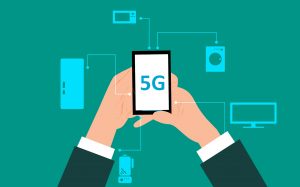The Industrial Internet of Things changes our view on the classic concept of production today. The largest manufacturing companies are eager to reach for technological solutions that streamline and increase the efficiency of production processes. With the development of subsequent technologies, interest in the concept of industry 4.0 increases, and thus, the number of connected devices. To meet the demand for infrastructure with adequate capacity and speed it was necessary to evolve towards the next generation of networks – 5G. How will 5G affect the development of Factories of the future and why is this crucial from the perspective of the Internet of Things? You will learn everything from the article.
What is a 5G network?
5G is the fifth generation of mobile telecommunications networks that will replace the currently used 4G LTE networks. This technology is a huge step forward in almost every area of modern life. It was created to solve the problem of the huge increase in the number of devices used every day. Furthermore, 5G enables faster data transmission and also improves the functioning of the Internet of Things, to which billions of devices are connected. Using the “5th generation” in practice creates the possibility of future implementation of further communication innovations as well.
Technically, the mobile network consists of:
- Radio Access Network (RAN) – consisting of various devices, such as towers, masts and cellular transmitters. They enable connecting users, mobile equipment and wireless networks with Core networks
- Core network – a means of data exchange that manages their transmission, internet connections and voice services. By definition, the 5G network works better with the Internet and telecommunications solutions that are based on cloud solutions. Another feature of the new standard is server dispersion. Fragmentation of network servers allows to reduce delays.
The 5G network will be implemented through ranges higher than currently used standards. Increasing their number will support more devices and their users. In the future, when outdated standards fade from everyday use, the ranges they use will also be transferred to the new 5G technology.
Digital revolution due to the 5G network

The 5G network plays a significant part in the digital revolution of the world around us. By using the potential of the new standard, it is possible to use all its functionalities.
The main advantages of 5G networks are:
- Data transfer speed – according to Orange network transmitters, it’s currently 225 Mb/s in 4G, and can reach up to 20Gb/s in 5G
- Reduction of delays in data transmission – currently the average values for 4G in Poland are from 33 ms to 44 ms, due to new technology, this value will decrease to 3 – 1 ms.
- Increasing connection stability – the transfer will enable data streaming even in the vicinity of numerous devices connected to the Internet. With 5G, devices can send and receive data even when the density is one million devices per square kilometer. Currently, the 4G standard allows communication of 100,000 devices per square kilometer.
It’s due to the performance of this innovative technology that the Internet of Things (IoT) expands its capabilities.
Internet of Things and 5G networks
The Internet of Things is a concept where devices can connect to systems or other devices over a network. They usually communicate wirelessly, so the huge potential of 5G is crucial here. In most cases, devices send data to a server, where they are collected, analyzed and processed. Readings from machines connected to the IoT network are sent without interruption, which is why the Internet of Things is often connected with Big Data. The base of all IoT is fast and efficient communication, which is why a solid base, which is the 5G network, allows to build better, more stable applications.
A leading trend in IoT is connecting more and more intelligent devices to the network – the development of the smart cars branch, smart cities or intelligent buildings. All these areas are based on connectivity, and current 4G  infrastructure has limited bandwidth. Today, this technology can no longer keep up with modern data flow needs, which can lead to functional errors. Imagine a situation in which, because of a congested link, a smart car does not receive information about the change of light from green to red on time. Delaying the information flow will delay the response and, as a result, can cause significant traffic congestion. Even more serious threats can occur when it comes to Healthcare IoT, where the reliability and stability of the data has a real impact on people’s lives and health.
infrastructure has limited bandwidth. Today, this technology can no longer keep up with modern data flow needs, which can lead to functional errors. Imagine a situation in which, because of a congested link, a smart car does not receive information about the change of light from green to red on time. Delaying the information flow will delay the response and, as a result, can cause significant traffic congestion. Even more serious threats can occur when it comes to Healthcare IoT, where the reliability and stability of the data has a real impact on people’s lives and health.
Connected machines – the Industrial Internet of Things
In the industrial Internet of Things, mainly machines from production lines communicate. They have sensors that measure various attributes, such as the temperature of a particular device, which after being moved to the platform can be monitored and analyzed. This involves a huge amount of readings – data, for which transmission speed is absolutely crucial. The essential advantages of a 5G network are speed and stability, factors that directly translate into significant performance optimization.
An example of a complete platform designed to meet all market needs in the field of Industrial Internet of Things is ThingWorx. It enables, for example, very fast development and implementation of complete IoT apps, due to which we can easily build a connection between physical devices and the application and use the full potential of the Internet of Things.
Applications built using ThingWorx collect and analyze data, which translates into real profits. By using Machine Learning and in-depth analysis of readings collected from real devices, it’s even possible to predict events. This helps prevent situations such as excessive use on the machine that will cause downtime and losses if it breaks down. Another advantage of the platform is the ability to monitor data in real time, which enables the observation of the state of the machine without having to access it. This facilitates the work of the device operator and also improves the flow of information on the status of entire production lines.
5G in the service of ThingWorx
Applications built on the ThingWorx platform will be the first to benefit from the 5G network due to connectivity enabling them to communicate with real IoT devices. By using this technology, the platform’s performance will significantly increase, at the level of the aforementioned connectivity, thereby increasing the capacity of the streamed data.
The IoT platform is used to aggregate data from various sources. Better network bandwidth will minimize the risk of blocking data flow and remote control. Thanks to 5G, we can also connect more intelligent products with each other, as well as processes and systems. An additional advantage is the ability to optimize response time. This is essential when making decisions that must be based on reliable and therefore always up-to-date data.
 IoT also works closely with augmented reality (AR) to improve team efficiency, simplify processes, and reduce training time. Using combined technologies, we can talk about the era of Employee 4.0 – a person who effectively and flawlessly performs the tasks entrusted from the first day of employment. For instance, Vestas, the largest wind turbine manufacturer in the world, has decided to implement such a solution. Due to the integration of the Internet of Things with AR, it was possible to create non-contact access to work instructions, allowing faster training of employees in the field of production tasks. Feel free to read about the complete implementation of the contactless solution and all its advantages and details in this article.
IoT also works closely with augmented reality (AR) to improve team efficiency, simplify processes, and reduce training time. Using combined technologies, we can talk about the era of Employee 4.0 – a person who effectively and flawlessly performs the tasks entrusted from the first day of employment. For instance, Vestas, the largest wind turbine manufacturer in the world, has decided to implement such a solution. Due to the integration of the Internet of Things with AR, it was possible to create non-contact access to work instructions, allowing faster training of employees in the field of production tasks. Feel free to read about the complete implementation of the contactless solution and all its advantages and details in this article.
The 5G network offers great opportunities for IoT development. Both the ThingWorx platform and applications developed using it can operate more efficiently, which directly reduces the generated costs. Applications implemented using ThingWorx in combination with the speed of data transfer provided by 5G technology is a guarantee of an efficient system that brings profit in business.
Join the digital revolution in the Internet of Things
With the development of the world, the communication infrastructure is also changing. The new 5G technology opens up new opportunities that are becoming crucial to the evolution of Industry 4.0 in the current era of digital transformation. This is a perfect moment to think about the company’s development and take advantage of the opportunity to improve production processes.
In order not to abuse your own IT resources, it’s worth using the services of an implementation company that specializes in creating applications for Industry 4.0 using the IoT platform like ThingWorx. If you are looking for a business partner who will implement your concept, or would like to start your first IoT project, contact us! We have experience in this area, and our implementations have already helped many companies optimize production costs and increase the efficiency of existing resources.
